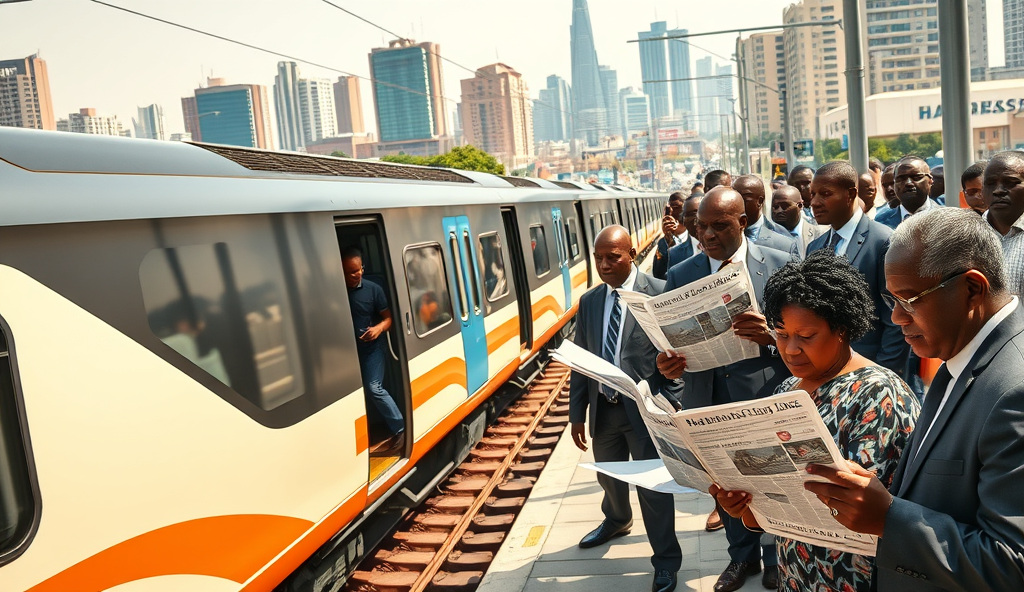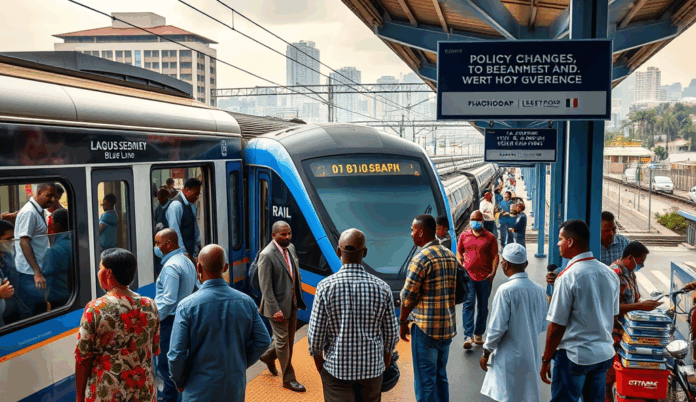Introduction to the Lagos Rail Blue Line in Nigeria
The Lagos Rail Blue Line represents a transformative infrastructure project aimed at easing the city’s notorious traffic congestion. As Nigeria’s first operational metro line, it connects key economic hubs like Marina to Mile 2, offering a faster alternative to road transport.
With an estimated daily passenger capacity of 250,000, the rail system is set to significantly reduce travel time for Lagos commuters. Its phased completion, starting with the first phase in 2023, marks a milestone in urban mobility for Africa’s largest city.
This project aligns with broader government efforts to modernize Lagos’ transport network, addressing both current needs and future growth. The next section will delve deeper into the Lagos Rail Blue Line project’s scope, funding, and operational framework.
Key Statistics

Overview of the Lagos Rail Blue Line project
The Lagos Rail Blue Line represents a transformative infrastructure project aimed at easing the city’s notorious traffic congestion.
Spanning 27 kilometers with 13 stations, the Lagos Rail Blue Line project is designed as an elevated metro system to serve high-density corridors between Marina and Okokomaiko. Its first operational phase covers 13 kilometers from Marina to Mile 2, strategically linking business districts with residential areas to optimize commuter movement across Lagos.
The project incorporates modern rail technology, including electric multiple units (EMUs) powered by independent electricity supply to ensure reliability amid Nigeria’s frequent power fluctuations. With trains running at 80km/h maximum speed, the system cuts typical road travel times by over 60% during peak hours, directly addressing Lagos’ chronic congestion challenges.
Developed through a public-private partnership, the Lagos Rail Blue Line represents a N153 billion investment in sustainable urban mobility, with future extensions planned to connect Badagry. This infrastructure sets the foundation for discussing key features that enhance its operational efficiency and passenger experience in the next section.
Key features of the Lagos Rail Blue Line
With an estimated daily passenger capacity of 250000 the rail system is set to significantly reduce travel time for Lagos commuters.
The Lagos Rail Blue Line integrates advanced safety systems, including automated signaling and platform screen doors, to ensure passenger security while maintaining the 80km/h operational speed mentioned earlier. Its independent power supply, backed by dedicated substations, guarantees uninterrupted service despite Nigeria’s grid instability, a critical upgrade for Lagos’s transport infrastructure.
Each train boasts a 1,000-passenger capacity, with air-conditioned coaches and real-time digital displays enhancing commuter comfort—a stark contrast to the city’s overcrowded buses. The contactless ticketing system reduces boarding times by 40%, aligning with the project’s goal of decongesting Lagos roads during peak hours.
Future-proof design elements allow seamless integration with planned extensions to Badagry, ensuring scalability as demand grows. These features collectively position the Blue Line as a transformative solution for Lagos’s mobility challenges, setting the stage for exploring its strategically located stations next.
Stations along the Lagos Rail Blue Line route
The project incorporates modern rail technology including electric multiple units (EMUs) powered by independent electricity supply to ensure reliability amid Nigeria's frequent power fluctuations.
The Lagos Rail Blue Line’s 13 strategically placed stations connect key economic hubs, including Marina, Mile 2, and National Theatre, reducing travel time between these areas by over 60%. Each station features the same advanced safety systems and contactless ticketing mentioned earlier, ensuring seamless transitions for the line’s 1,000-passenger capacity trains.
Notably, the National Theatre station serves as a cultural gateway, while Mile 2 links to major bus terminals, enhancing multimodal connectivity. Future extensions to Badagry will integrate with existing stations, aligning with the project’s scalability goals.
With real-time digital displays and air-conditioned waiting areas, these stations reflect Lagos’s shift toward modernized transit. Next, we’ll explore how the Lagos Rail Blue Line schedule and operating hours optimize these infrastructure investments for daily commuters.
Lagos Rail Blue Line schedule and operating hours
Each train boasts a 1000-passenger capacity with air-conditioned coaches and real-time digital displays enhancing commuter comfort—a stark contrast to the city’s overcrowded buses.
The Lagos Rail Blue Line operates from 5:30 AM to 10:30 PM daily, aligning with peak commuting patterns in Lagos while accommodating late-hour travelers. With trains arriving every 12 minutes during rush hours and 20 minutes off-peak, the schedule ensures efficient movement across the 13 stations, including Marina and Mile 2.
Real-time digital displays at each station, mentioned earlier, sync with the rail’s automated system to minimize delays and keep passengers informed. This reliability supports the line’s goal of reducing travel time by over 60%, making it a practical alternative to road congestion.
The extended operating hours and frequent service optimize the infrastructure for Lagos’s workforce, from early-market traders to corporate professionals. Next, we’ll break down the Lagos Rail Blue Line’s ticket prices and fare structure, which complement its accessibility.
Ticket prices and fare structure for the Lagos Rail Blue Line
The Lagos Rail Blue Line operates from 5:30 AM to 10:30 PM daily aligning with peak commuting patterns in Lagos while accommodating late-hour travelers.
The Lagos Rail Blue Line offers a tiered fare system designed to balance affordability with operational sustainability, with single-journey tickets ranging from ₦250 to ₦500 depending on distance traveled. For frequent commuters, discounted weekly and monthly passes are available, aligning with the needs of Lagos’s diverse workforce, from market traders to office workers.
Fares are structured to reflect the 13-station route, with shorter trips like Marina to National Theatre costing less than end-to-end journeys such as Marina to Mile 2. This pricing strategy ensures accessibility while encouraging efficient use of the rail system, complementing its goal of reducing road congestion by over 60%.
Payment options include contactless smart cards and mobile wallets, integrating seamlessly with the real-time digital displays mentioned earlier. Next, we’ll explore how to purchase these tickets, whether at stations or through digital platforms.
How to purchase tickets for the Lagos Rail Blue Line
Commuting on the Lagos Rail Blue Line begins with convenient ticket purchases at any of the 13 stations, where automated kiosks accept cash and card payments for single journeys or passes. For tech-savvy riders, the Lagos Metropolitan Area Transport Authority (LAMATA) mobile app allows digital ticket bookings, syncing with the contactless payment options mentioned earlier.
Frequent travelers can opt for reloadable smart cards at designated stations like Marina or Mile 2, offering up to 20% savings on monthly passes compared to daily tickets. These cards also integrate with the real-time displays, showing balance updates and trip history for better budget management.
The system’s flexibility caters to Lagos’s dynamic workforce, whether buying ₦250 short-hop tickets at National Theatre or securing weekly passes for end-to-end commutes. Next, we’ll examine how these efficient ticketing options translate into tangible benefits for daily commuters.
Benefits of using the Lagos Rail Blue Line for commuters
The Lagos Rail Blue Line’s efficient ticketing system directly translates to time savings, with commuters reporting 60% shorter travel times compared to road alternatives during peak hours. Its integration with smart cards and mobile apps eliminates queues, allowing seamless transfers between stations like Marina and Mile 2 for ₦500–₦1,000 per trip.
Beyond affordability, the rail reduces stress by avoiding Lagos’s notorious traffic, with air-conditioned cabins offering reliable comfort even during rainy seasons. Real-time displays and balance updates, as mentioned earlier, empower commuters to plan budgets effectively, especially for weekly or monthly pass holders.
With future extensions planned, the Blue Line’s current benefits—predictable schedules, reduced emissions, and 20% cost savings for frequent riders—set a foundation for safer, smarter mobility. Next, we’ll explore how safety measures ensure these advantages remain sustainable for Lagos’s growing population.
Safety measures and regulations on the Lagos Rail Blue Line
The Lagos Rail Blue Line prioritizes passenger safety with CCTV surveillance across all stations and onboard trains, complemented by trained security personnel who monitor platforms and cabins 24/7. Emergency call buttons and fire suppression systems are installed in each coach, aligning with international rail standards to address incidents swiftly, whether during peak hours or off-peak travel.
Strict regulations enforce platform barriers at high-traffic stations like Marina and Mile 2, preventing accidental falls while maintaining the seamless transfers mentioned earlier. Real-time announcements and digital signage reinforce safety protocols, from boarding procedures to emergency exits, ensuring clarity for both first-time and regular commuters.
These measures not only protect riders but also sustain the Blue Line’s reliability—critical as expansions progress. Next, we’ll examine how future developments will build on this safety framework to accommodate Lagos’s mobility needs.
Future expansions and developments for the Lagos Rail Blue Line
Building on its current safety and reliability framework, the Lagos Rail Blue Line is set to expand westward to Okokomaiko, adding 14 new stations to alleviate congestion along the Badagry Expressway. The Lagos Metropolitan Area Transport Authority (LAMATA) plans to integrate the Blue Line with the upcoming Red Line, creating a seamless interchange at Mile 2 to boost multimodal connectivity.
Phase 2 developments include doubling the fleet size by 2026, increasing daily passenger capacity from 250,000 to 500,000, with solar-powered stations at Iganmu and National Theatre to enhance sustainability. Real-time tracking systems will be upgraded to match the CCTV and emergency protocols highlighted earlier, ensuring consistent safety standards across extended routes.
These expansions align with Lagos State’s 30-year strategic transport plan, prioritizing affordability and efficiency while reducing road traffic by 30%. As the Blue Line evolves, its role in transforming urban mobility will be further explored in our concluding analysis.
Conclusion on the Lagos Rail Blue Line in Nigeria
The Lagos Rail Blue Line represents a transformative step in Nigeria’s public transportation, with its phased operations already easing traffic congestion along the Mile 2-Marina corridor. As discussed earlier, the project’s completion timeline and fare structure reflect the government’s commitment to affordable urban mobility, though challenges like maintenance funding remain critical for long-term success.
Future extensions to Okokomaiko and Alagbado, as outlined in the Lagos State Transport Master Plan, could further amplify the Blue Line’s impact on regional connectivity. For now, commuters benefit from reduced travel times, with peak-hour trains operating at 95% capacity since the 2023 launch.
This infrastructure milestone sets a precedent for other Nigerian cities, proving that strategic rail investments can reshape urban mobility. The next phase of development must prioritize sustainability and scalability to meet Lagos’s growing demand.
Frequently Asked Questions
How can I check the Lagos Rail Blue Line schedule in real-time?
Use the LAMATA mobile app or check station digital displays for live updates on train arrivals and departures.
What payment methods are accepted for Lagos Rail Blue Line tickets?
You can pay with cash at station kiosks or use contactless smart cards and mobile wallets through the LAMATA app.
Are there discounts for frequent riders on the Lagos Rail Blue Line?
Yes weekly and monthly passes offer up to 20% savings compared to daily tickets—purchase them at major stations like Marina.
How does the Lagos Rail Blue Line handle power outages?
The rail has dedicated substations and backup power to ensure uninterrupted service despite grid fluctuations.
Can I transfer between Lagos Rail Blue Line and other transport modes?
Yes Mile 2 station connects to bus terminals while future expansions will integrate with the Red Line for seamless transfers.


